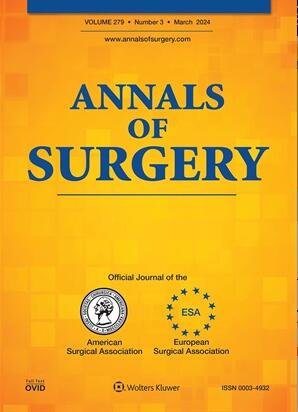Comprehensive Review of the Management of Patients with Acute Cholecystitis Who Are Ineligible for Surgery.
IF 7.5
1区 医学
Q1 SURGERY
引用次数: 0
Abstract
OBJECTIVE Review the current literature for available treatments for acute cholecystitis (AC) in non-surgical candidates and provide guidelines for the management of these patients. BACKGROUND Cholecystectomy is the gold standard treatment modality for AC. A considerable number of patients who are not eligible for surgery are managed by percutaneous and endoscopic techniques. There is recent data regarding endoscopic ultrasound-guided gallbladder drainage (EUS-GBD) and emerging percutaneous approaches to address cholelithiasis and remove drains. METHODS An expert panel of surgeons, gastroenterologists, and interventional radiologists reviewed the current literature and provided recommendations for AC management in non-surgical candidates. Recommendations were based on relevant evidence, with quality and strength assessed using the Grading of Recommendations Assessment, Development and Evaluation (GRADE) framework. RESULTS Percutaneous cholecystostomy (PC) is advised for patients ineligible for lumen-apposing metal stent (LAMS) or with reversible conditions, aiming to bridge to cholecystectomy. The optimal timing of cholecystectomy after PC remains unclear. In cases where surgery is not feasible, potential definitive treatments such as percutaneous cholecysto-lithotripsy/lithectomy and cholecystoduodenal stenting should be considered. For calculous AC, EUS-GBD with LAMS is recommended as a therapy for never-surgical candidates if they are eligible for monitored anesthesia care or general anesthesia and there is institutional expertise and minimal intervening ascites. CONCLUSIONS The management of AC in non-surgical candidates remains a challenge, with institutional protocols varying based on physician preferences and expertise. The proposed protocol integrates percutaneous and endoscopic approaches and emphasizes the need for multidisciplinary collaboration. Further research is required to evaluate these evolving management techniques, as the current literature is limited.全面回顾不符合手术条件的急性胆囊炎患者的治疗方法。
目的回顾目前有关非手术治疗急性胆囊炎(AC)的文献,为这些患者的治疗提供指导。背景胆囊切除术是AC的金标准治疗方式。相当多不符合手术条件的患者通过经皮和内镜技术进行治疗。最近有关于内镜下超声引导胆囊引流术(EUS-GBD)和新兴的经皮入路治疗胆石症和清除引流管的数据。方法由外科医生、胃肠病学家和介入放射科医生组成的专家小组回顾了目前的文献,并为非手术患者的AC治疗提供了建议。建议以相关证据为基础,使用建议评估、发展和评估分级(GRADE)框架评估质量和强度。结果对于不适合行置管金属支架(LAMS)或病情可逆的患者,建议行经皮胆囊造瘘术(PC),为胆囊切除术搭建桥梁。胆囊切除术后胆囊切除术的最佳时机尚不清楚。在手术不可行的情况下,应考虑潜在的决定性治疗,如经皮胆囊碎石/结石切除术和胆囊十二指肠支架置入术。对于结石性AC,如果有资格接受麻醉监护或全身麻醉,并且有机构专业知识和最小的干预腹水,则推荐EUS-GBD联合LAMS作为从未手术的候选人的治疗方法。结论:非手术候选人的AC管理仍然是一个挑战,机构方案根据医生的偏好和专业知识而变化。拟议的方案整合了经皮和内窥镜方法,并强调多学科合作的必要性。由于目前的文献有限,需要进一步的研究来评估这些不断发展的管理技术。
本文章由计算机程序翻译,如有差异,请以英文原文为准。
求助全文
约1分钟内获得全文
求助全文
来源期刊

Annals of surgery
医学-外科
CiteScore
14.40
自引率
4.40%
发文量
687
审稿时长
4 months
期刊介绍:
The Annals of Surgery is a renowned surgery journal, recognized globally for its extensive scholarly references. It serves as a valuable resource for the international medical community by disseminating knowledge regarding important developments in surgical science and practice. Surgeons regularly turn to the Annals of Surgery to stay updated on innovative practices and techniques. The journal also offers special editorial features such as "Advances in Surgical Technique," offering timely coverage of ongoing clinical issues. Additionally, the journal publishes monthly review articles that address the latest concerns in surgical practice.
 求助内容:
求助内容: 应助结果提醒方式:
应助结果提醒方式:


